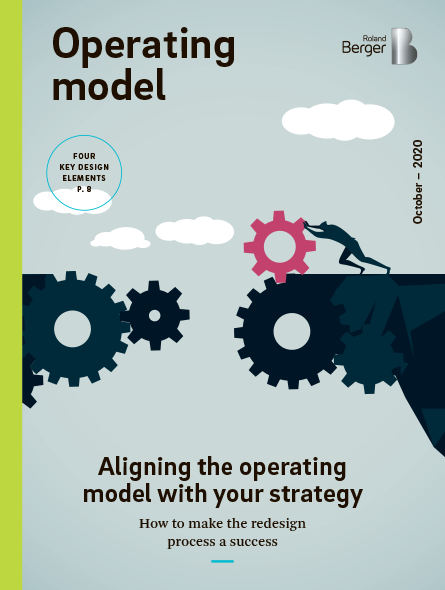Redesign your operating model: Successfully linking strategy and execution
![{[downloads[language].preview]}](https://www.rolandberger.com/publications/publication_image/615_roland_berger_operating_model_redesign_ad_cover_download_preview.png)
A fit-for-purpose operating model is of paramount importance, especially through the current crisis.


An operating model defines how a company goes about delivering on its purpose. Before the COVID-19 crisis, many businesses already suffered from operating models which had undergone incremental and unstructured changes over time, becoming often hidden barriers to organisations delivering on their strategy. Now, through COVID-19, businesses are having to restructure under extreme pressure, and risk drifting further away from achieving their long-term goals. Redesigning and implementing a fit-for-purpose operating model is thus of paramount importance, especially through the current crisis.
"The operating model is the key element to create value and deliver the company's purpose in a constantly changing business environment."
Over the years, as a company develops and transforms and the surrounding environment shifts, its operating model naturally adapts as well . Although this flexibility is an advantage, over time the changes also may mean that the complexity of the model keeps increasing with each adaptation. To ensure the operating model remains effective, companies need to systematically review and redesign it – yet this is often put off due to perceived risk and workload. Conversely, the real threat for companies lies precisely in avoiding redesigning their operating model. Our white paper looks at the possible drawbacks of working with an outdated model, the advantages of creating a fit-for-purpose operating model and the main challenges companies may encounter. It also outlines tried-and-tested approaches and key factors for a successful redesign.
The operating model defines how a company develops and maintains the capabilities that are required to deliver its strategy and how it fulfills its stakeholder expectations. A fit-for-purpose operating model arises from "why" the company exists, "what" its purpose is, and "how" it plans to achieve the outcome of the strategy. When done right, it becomes a source of consistent and coherent guidance to all the stakeholders in the company – employees, customers, suppliers, management and shareholders.
Prevailing operating models are often a result of an unstructured legacy rather than a deliberate construct. Through internal and external developments over the years, companies keep extending the model incrementally, which creates an outdated operating model.
Although it may seem inconsequential, working with models that do not fit the current requirements of the market means that companies often fail to effectively coordinate their resources, reach their desired return on invested capital and effectively take advantage of new opportunities. Furthermore, inefficient operating models increase complexity in and around the company making it harder to understand and execute the strategy.
Download our full white paper to find out how to properly face the challenges of redesigning your operating model and how to overhaul it with Roland Berger's four-step approach for a fit-for-purpose model.
![{[downloads[language].preview]}](https://www.rolandberger.com/publications/publication_image/615_roland_berger_operating_model_redesign_ad_cover_download_preview.png)
A fit-for-purpose operating model is of paramount importance, especially through the current crisis.
